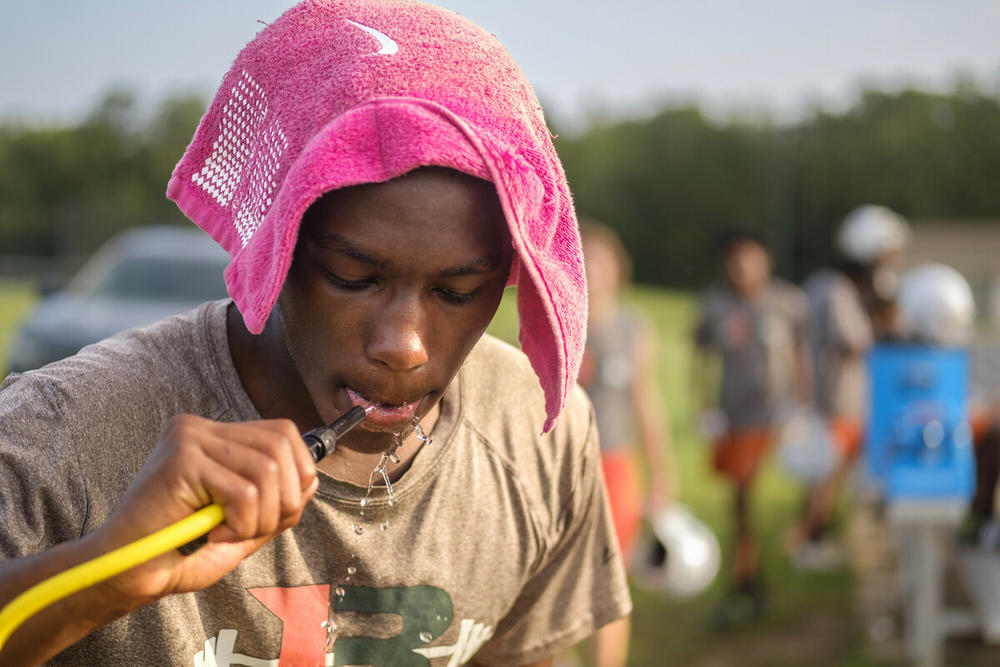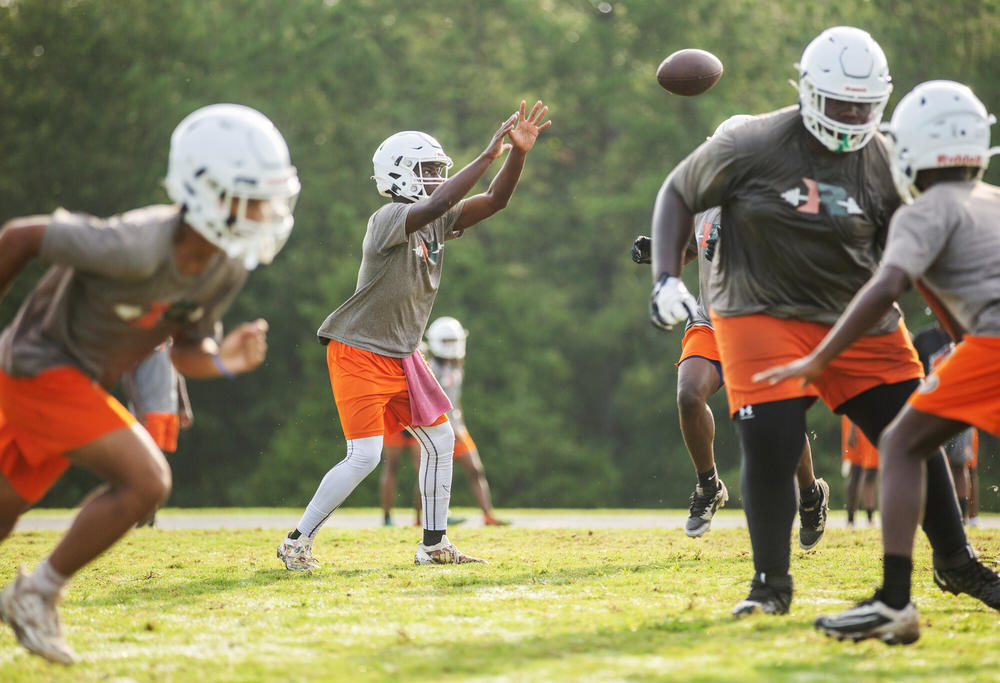
Caption
Football teams now take more frequent water breaks compared to past years, in order to fight heat exhaustion.
Credit: Grant Blankenship/GPB News
|Updated: August 16, 2024 12:39 PM
LISTEN: People commonly hear about the heat index, but that is not the best measure when considering safety of outdoor sports. GPB's Ellen Eldridge has more.

Football teams now take more frequent water breaks compared to past years, in order to fight heat exhaustion.
Georgia led the nation with 58 deaths related to extreme heat between 1980 and 2009, according to research from the University of Georgia.
A lack of organized oversight contributed to those deaths, the majority of whom were high school football players.
Bud Cooper helped change that.
He’s the clinical professor in UGA’s Mary Frances Early College of Education Department of Kinesiology.
Following public outrage over two high-profile deaths, the Georgia High School Association approached Cooper, who proposed a three-year study of heat-related illness trends and policies related to outdoor high school activities.
In the spring of 2012, Cooper showed the GHSA’s executive committee evidence-backed data that August practices are the riskiest for outdoor movement.
Together, a set of standards were written and published.
People commonly hear about the heat index, which is based on an individual who is 5 feet 7 inches tall, weighs 147 pounds, is wearing a short-sleeved shirt, long pants, and walking 3 miles per hour in the shade, Cooper said.
“That formula with which the heat index is based has no correlation whatsoever to high-intensity athletic activity,” he said.
The Wet Bulb Globe Temperature (WBGT) assesses environmental conditions as well as temperature to determine the risk of heat illness.
For example: Go outside at any given time on a sunny day in August and put your hand on asphalt or a brick building to feel the absorbed heat.
“The same thing happens to an individual,” Cooper said. “When you are out in a very sunny area, you not only have the air temperature and you have the humidity, but you're going to have the sun baking down on you, and that's going to increase your core temperature as well.”
Dr. Elaine Jones, a neurologist who evaluates emergency patients nationwide via telehealth, said people — especially those with neurologic diseases such as multiple sclerosis — might not recognize the physical effects of extreme heat at first.
“We also know, of course, that people, when it's hot, get more irritable,” she said. “People tend to eat less when they're really hot. I mean, these are kind of things that, you know, I think we're all familiar with. So, there's no question that temperature affects us, and we may not always realize how.”
Hydration protects players best from extreme heat and humidity, she said.
“As you sweat, you become less hydrated,” she said. “You lose water. You also lose electrolytes. So that's why people often say, you know, drink Gatorade or something with electrolytes.”
Heard County High School recently opened a covered 70-yard facility to protect players from heat as well as storms, head football coach Shane Lasseter said.
He said the WBGT this summer was through the roof, and, while many players wore only helmets during practice, his team could wear full pads because the facility took 20 degrees off the outside temperature.
“We're humbled to have it,” Lasseter said. “I don't feel like any high school coach deserves to have the facilities that we have and are blessed to have, and so we try not to take it for granted at all.”
Athletes and coaches throughout Georgia must follow specific guidelines as the temperature gets warmer because, while exertional heat stroke can be catastrophic, death is 100% preventable if caught early, Cooper said.
Death can occur when the core body temperature is 104 degrees or higher.
The GHSA policy mandates that whenever the wet bulb low temperature is 86 or higher, each individual school must have a cold-water immersion tub on site and ready to go.
“That is the gold standard for treating a heat stroke,” Cooper said, noting that ambulances are not equipped to cool a person’s core temperature before they get to the hospital and, even then, may not have an emergency cooling plan.
“So, the mindset for that is ‘cool first, transport second,’” Cooper said.

Macon's Rutland High School football team, the Hurricanes, practice early in the morning and without full pads recently. Rules for practice now describe a ramp up from no helmets to five days in a row in helmets before finally going to full pads, all in an effort to acclimate athletes to the heat.
Georgia has not seen any deaths related to heatstroke when the GHSA policies were followed, and that’s important, he said, because a 16-year-old high school basketball player in Atlanta died of heat stroke.
Coaches forced Imani Bell to practice basketball drills outside in July 2019 on the school’s football field, according to a lawsuit.
“They denied her water and they made her run stadium steps,” Cooper said, “and they did it until she collapsed. Had they followed the policy, I'm sure that young girl would still be with us today.”
In 2022, the Clayton County Board of Education settled a civil lawsuit filed by Bell’s family with $10 million and no admission of wrongdoing.
“Coaches now know they will be held accountable — and the school — if they don’t protect their kids from heat exhaustion,” lawyer L. Chris Stewart said at the time.
Some schools, such as in Oconee and Madison counties, hold August practices at 6 a.m., Cooper said, and hydration breaks are required during games when the weather heats up.
It is not viewed as a timeout, so the coaches are not allowed out on the field, Cooper said.
Rest breaks can increase to twice per quarter when necessary.
The rules are yearlong and apply to cross country, tennis, soccer, softball, baseball and marching band.
"In so many of the high schools their marching band wears like a wool uniform," he said. "And, you know, that's probably worse than the football player wearing shoulder pads and helmets and other things."